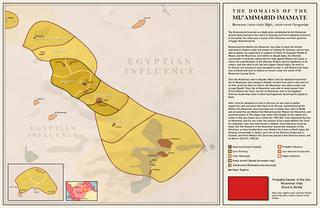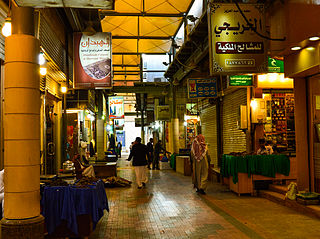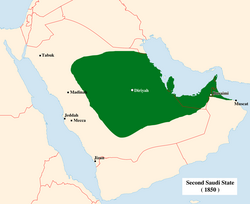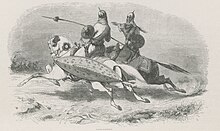
The House of Saud is the ruling royal family of Saudi Arabia. It is composed of the descendants of Muhammad bin Saud, founder of the Emirate of Diriyah, known as the First Saudi state (1727–1818), and his brothers, though the ruling faction of the family is primarily led by the descendants of Abdulaziz bin Abdul Rahman, the modern founder of Saudi Arabia. It forms a subtribe of the larger prominent ancient Banu Hanifa tribe of Arabia, from which well known 7th century Arabian theologist Maslama ibn Ḥabīb originates. The most influential position of the royal family is the King of Saudi Arabia, an absolute monarch. The family in total is estimated to comprise 10,000 to 20,000 members; however, the majority of power, influence and wealth is possessed by a group of about 2,000 of them. Some estimates of the royal family's wealth measure their net worth at $1.4 trillion.This figure includes the market capitalization of Saudi Aramco, the state oil and gas company, and its vast assets in fossil fuel reserves, making them the wealthiest family in the world and the wealthiest in recorded history.

Abdul Rahman bin Faisal Al Saud was the last emir of Nejd, reigning from 1875 to 1876 and from 1889 to 1891. He was the youngest son of Emir Faisal bin Turki bin Abdullah and the father of Abdulaziz, the founder of the Kingdom of Saudi Arabia.
Saud bin Abdulaziz Al Saud ruled the First Saudi State from 1803 to 1814. Saud annexed Mecca and Medina from the Ottoman Empire making him the first Al Saud ruler who received the title of the servant of the Two Holy Cities. During his rule the state experienced a significant level of strength and expansion for which he was called Saud Al Kabeer or Saud the Great.

The Rashidi dynasty, also called Al Rashid or the House of Rashid, was a historic Arabian House or dynasty that existed in the Arabian Peninsula between 1836 and 1921. Its members were rulers of the Emirate of Ha'il and the most formidable enemies of the House of Saud, rulers of the Emirate of Nejd. They were centered in Ha'il, a city in northern Najd that derived its wealth from being on the route of the Hajj pilgrimage to Mecca, and was also a commercial center. The rulers of Ha'il were the sons of Abdullah bin Rashid, founder of the dynasty.
Faisal bin Turki Al Saud was the second ruler of the Second Saudi State and seventh head of the House of Saud.
Turki bin Abdullah Al Saud was the founder of the Second Saudi State and ruled Najd from 1823–1834 following administration by the Ottoman Empire.
Saud bin Faisal Al Saud, also known as Imam Saud, (1833—1875) was the ruler of the Second Saudi State in 1871 and 1873–75. He joined alliances with foreign tribes and revolted against his half-brother Abdullah. His rule was short-lived and Abdullah overthrew him. Saud gained power again in 1873 but died two years later. His reign was notable for the infighting in the House of Saud which he initiated.

The Unification of Saudi Arabia was a military and political campaign in which the various tribes, sheikhdoms, city-states, emirates, and kingdoms of most of the central Arabian Peninsula were conquered by the House of Saud, or Al Saud. Unification started in 1902 and continued until 1932, when the Kingdom of Saudi Arabia was proclaimed under the leadership of Abdulaziz, known in the West as Ibn Saud, creating what is sometimes referred to as the Third Saudi State, to differentiate it from the Emirate of Diriyah, the First Saudi State and the Emirate of Nejd, the Second Saudi State, also House of Saud states.

The Emirate of Jabal Shammar, also known as the Emirate of Haʾil or the Rashidi Emirate, was a state in the northern part of the Arabian Peninsula, including Najd, existing from the mid-nineteenth century to 1921. Jabal Shammar in English is translated as the "Mountain of the Shammar". Jabal Shammar's capital was Ha'il. It was led by the monarchy of the Rashidi dynasty. It included parts of modern-day Saudi Arabia, Iraq, and Jordan.
Muhammad bin Saud Al Muqrin, also known as Ibn Saud, was the emir of Diriyah and is considered the founder of the First Saudi State and the Saud dynasty, which are named for his father, Saud bin Muhammad Al Muqrin. His reign lasted between 1727 and 1765.
Abdullah bin Ali Al Rashid (1788–1848) was the founder of the Emirate of Jabal Shammar. He founded the Emirate in 1836 and ruled it until 1848. He was called Sheikh due to his noble lineage and military ability.
The Ministry of War was created 1744 to unify the Armed Forces of Saudi Arabia under one administrative structure. In 1933 it was renamed as the "Defense Agency" under the Ministry of Finance and headed by a Director-General. A few years later, the Agency was renamed as the Ministry of Defense.
Abdullah bin Faisal Al Saud was one of the rulers of the Emirate of Najd, also known as Second Saudi State. His reign witnessed extensive struggle among the members of the Al Saud family which led to turmoil in the region.
Khalid bin Saud bin Abdulaziz Al Saud (1811–1865) ruled the Second Saudi State, Emirate of Najd, for three years, between 1838 and 1841. His reign was part of Muhammad Ali Pasha's, ruler of Egypt, plans to dominate Arabia following his capture of Syria in 1831. Khalid was the great-grandson of Muhammad bin Saud, founder of the Al Saud dynasty, and second cousin of Faisal bin Turki bin Abdullah, another ruler of the Second Saudi State.
Abdullah bin Thunayan Al Saud was Emir of Nejd from 1841 to May 1843. He is the sole member of the Al Thunayan branch of the Al Saud who became emir.

The Mu'ammarid Imamate, also referred to as ibn Muammar's Imamate or Imamate of Diriyah, was a short-lived emirate created after the fall of the first Saudi state. It was based around the city of Diriyah and was briefly a vassal of Muhammad Ali, Ottoman governor of Egypt. The state did not last long, however, as it was reconquered by the Saudis and incorporated into the Second Saudi State.

The Expedition to Najd (1836) was a military operation organised by Ottoman military commander Muhammad Ali Pasha that invaded the Second Saudi State based in Najd after the refusal of tribute payments by its ruler, Imam Faisal bin Turki al-Saud.

Old Riyadh is an umbrella term used for a loosely defined region that primarily lies in the southern portion of modern-day Riyadh, Saudi Arabia, encompassing neighborhoods and settlements that emerged from ruins of Hajr al-Yamamah in late 16th century, the erstwhile walled town enclosed within the defensive fortifications and its immediate vicinity prior to its demolition in 1950, and villages and former towns located along the outskirts of Riyadh that got incorporated into the metropolis following multiple phases of expansion and modernization between the 1950s and 1970s. To some extent, neighborhoods excluded during Riyadh's rapid urbanization during the same period are also categorized as part of old districts, with most of them situated in the modern downtown.

Al-Hukm Palace, also known as the al-ʽAdl Palace, so called from the public square it overlooks from the south, is a historic palace and a popular cultural heritage landmark in the ad-Dirah neighbourhood of Riyadh, Saudi Arabia, located directly opposite to Imam Turki bin Abdullah Grand Mosque in the Qasr al-Hukm District. It is the historic site where tribal leaders and members of the Saudi royal family have been pledging allegiance to the country's political leadership. Built in 1747, it was known as Ibn Dawwas Palace until the 1820s, when Turki bin Abdullah, after gaining control of Najd, shifted the royal family's center of power from Diriyah to the walled town of Riyadh due to the former's severe destruction in a brutal siege during the Ottoman–Wahhabi War of 1818 as well as the town’s Ottoman sacking in 1821.

Saudi Founding Day, officially the Founding Day, is a public holiday in Saudi Arabia celebrated annually on February 22 to commemorate the enthronement of Muhammad bin Saud as the emir of the oasis town of Diriyah in 1727 following the death of his father Saud al-Muqrin, the eponymous ancestor of the al-Saud family. His hereditary succession is considered as the prelude to the inception of the First Saudi State, the antecedent to the Second Saudi State and present-day Kingdom of Saudi Arabia. It was founded in 2022 on its 295th anniversary when King Salman bin Abdulaziz issued a royal decree that designated it as a legal holiday to be observed as per the Gregorian calendar. It is one of the three non-religious national holidays observed in the country, other being the Saudi National Day and Saudi Flag Day.













